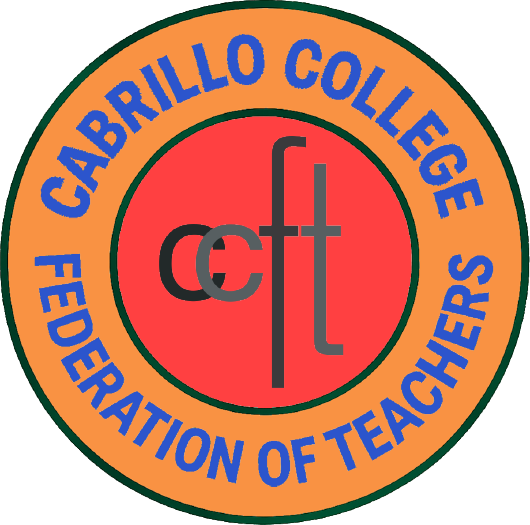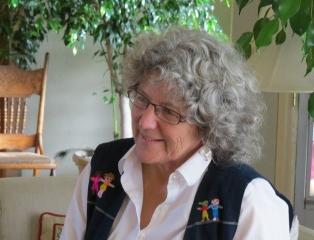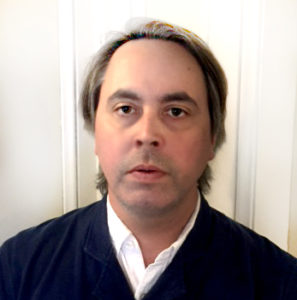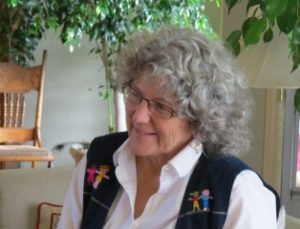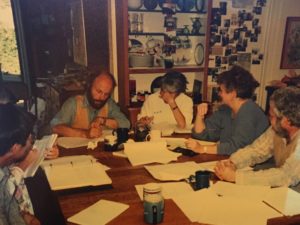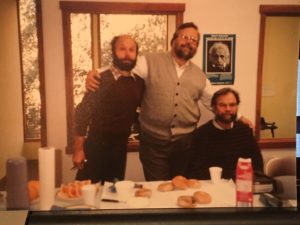There is an intensity and vehemence of purpose in the voice of Julie Olsen Edwards. The daughter of two leftists—Tillie Olsen, the journalist and legend of the short story, was her mother; her father Jack Olsen, a warehouse worker and organizer for the International Longshore and Warehousemen’s Union (ILWU), was a veteran of the great labor battles of the 1930s—Olsen Edwards was formed in a family atmosphere of heightened class consciousness.
She knew from her parents the fruits and hopes as well as the difficulties of the organized labor movement on the United States’ inhospitable terrain. In the 1930s, her mother had worked as a farm labor organizer during an unsuccessful drive in Stockton. Her writings from these years appeared in Partisan Review and The Nation. Her father went from organizer to director of the San Francisco City College’s venerable Labor Studies Program.
Olsen Edwards started at Cabrillo in 1971, retired in 2010, but only stopped teaching a year ago. Even now, she’s still directing the Children’s Peace and Anti-bias Library in the ECE building. In that time she was the first director of the Cabrillo Children’s Center, Chair of the ECE Department, one of the founders of Cabrillo’s now defunct Women’s Studies Program, and a union leader at Cabrillo.
As part of our effort at CCFT to educate members about the importance of union membership, I spoke with Julie about the origins of CCFT during the height of the Reagan years. CCFT and other locals now face new challenges as the Janus decision looms.
We met for a sit-down interview in April at her sunny home in Soquel. We began by talking about her experiences as a faculty member in the 1970s. We touched on the Early Childhood Education and the Women’s Studies Program. The latter program was born out of 250 students attending the first class offered on the topic. “There was such a hunger for this material,” Olsen Edwards said. The department and the women’s center were the first of their kind a community college. And now they are gone.
She riffed on a famous line from Jefferson as she reflected on what was lost. “Jefferson wrote that the price of freedom is eternal vigilance. Well, the price of building anything is eternal vigilance. It’s very hard to keep. If you create something or make something unusual successful, it takes a great deal to make sure it becomes truly part of an institution.” And from here we moved into a discussion of the early history of our union, AFT Local 4400.
Campus in the Early Days
I began by asking her about the situation for faculty and students at Cabrillo before the union. In the 1970s, Olsen Edwards noted, community colleges were well funded. “We had a terrific administration in some ways.” She recalled President Bob Swenson very fondly: “There was a general attitude that faculty knew what they were doing.” Faculty members were given room for creative initiative in a time of healthy state budgets for education. The founding faculty members at Cabrillo enjoyed these pristine conditions.
Administrative collaboration with faculty was certainly the case for full-time academic faculty; but such deference did not exist for faculty, like Olsen Edwards, in occupational programs, where required teaching loads were heavier. It was certainly not true for adjunct faculty, or UPTs, a dated acronym for part-timers that stands for unit-pay temporary. The first CCFT newsletter from February 1985 closes with Rosmarie Greiner’s article on unit-pay faculty. The terse and informative article is based on a November 1984 survey of 195 unit-pay faculty.
“That was the disgusting name for adjunct faculty,” she said. So the campus, very much in its glory days, had many big divides too. “As the 1970s rolled along, things got harder and harder at Cabrillo.”
The Reagan years as governor in California as well as the tax revolt that led to the passage of Proposition 13 both fundamentally altered the funding of the education system. These developments were coupled with Cabrillo’s new administration that was not as faculty focused.
“The divides on campus got worse and worse,” she said.
The Faculty Voice Came Back
Olsen Edwards dated the fundamental shift in faculty and administration relations to the tenures of President’s Peterson and Arguela. Prior to this, the Faculty Senate had been the strong voice taken very seriously by administration. And Division Chairs were chosen by the faculty with the task of representing and supporting their programs.
Olsen Edwards put it succinctly, “In the early years, the Senate would come up with decisions on things and those decisions were supported by the administration.” This support for Senate decisions began to disappear.
I asked her about what happened as a result.
“As faculty felt more and more disenfranchised by decision making on campus, and as the Divisions got bigger there was more polarization. A group of us got together and thought it was time that Cabrillo got unionized,” she said.
It all started with a series of off-campus meetings where a wide-range of issues was discussed. This small nucleus of activists eventually brought these meetings to campus itself.
Initially there were four options for a union. Some faculty wanted no union. Both CFT and CTA were consulted and some faculty preferred the idea of a stand-alone Cabrillo union. These were important days and emotions were high.
“There was this feeling that people wanted to get the faculty voice back,” she said.
She added: “There was also a split among the pro-union faculty: if we did unionize, some thought there should be one for the part-timers and one for the full-timers because our issues were so different. And then there was a crew of us that said ‘We go together or we don’t go’.”
A preliminary election had to take place. Faculty signed cards to indicate they wanted an election to take place. Enough cards were gathered and the election went ahead. The choices for the decisive vote were for no union, AFT, or CTA, and CTA was not going to organize the adjunct faculty. Speakers came to campus. Newsletters were published. Many issues began to surface in the run up to the vote.
“It was about a two-year process,” Olsen Edwards said. “And what happened is that the inequities that existed, the hierarchy, the differential in how people were treated—was all suddenly made bare. It had all been there but nobody talked about it except muttering and mumbling: the difference in teaching loads; the fact that the Senate was being less and less heard.
“Part of what happened in all of that: the people who had founded the campus, the earliest faculty, were fabulous teachers and really had built terrific programs. They saw themselves as professionals and professionals don’t unionize.”
So yet another divide began to emerge in all of this intense organizing. “There was a real class divide. Most of us who organized the union grew up working class. We knew damn well we were employees. We knew we were workers,” she said with humorous, class-conscious aplomb.
A Momentous Occasion
For Olsen Edwards and others the union drive was less about salary, evaluation, and all the things faculty rely on the union to do. “The heart of it was the faculty’s right to be part of the governance of the school. And concurrently, it was about the recognition of adjuncts as full-fledged members of the faculty.”
“It was a hard struggle,” Olsen Edwards said. In the end, the campus voted overwhelmingly to unionize. “We said we need a union here; we have to have to a way that faculty voice is heard here.”
Faculty voted for AFT. “We were all ecstatic. We’d been working so hard,” Olsen Edwards said. “And we were all still teaching full- and part-time and had these massive teaching loads. Nobody got time off to do union work at that point.” She recalled, “I still have some snapshots of us partying that weekend.”
The vote for AFT caused some dissent because some faculty supported CTA; they didn’t get their union and some had wanted no union at all. Even in the beginning, then, there were blocks, groups, little factions. There was also tremendous excitement.
A temporary council took shape. Every division had an election and sent four people to the temporary body. We talked about how we wanted to function. Olsen Edwards took notes. “I wrote them up into a Constitution.”
It was a scramble and jobs were practically dumped on people. The council elected co-Chairs, Dick Lundquist, a faculty member in English and Nancy Andrersen, from the ECE Department. “It was English, Art, ECE, Biology, and Chemistry. They were where the hotbeds of activity were,” she noted.
Crucial faculty helped form the key union cadre in those early years; these included Harry Ungar, Mort Marcus, Dougald Scott, Howard Ikemoto, Kirby Wilkins, Grace Daniel, Julie Miller, Rosmarie Greiner, Alan Lonnberg, T. Mike Walker, and Carl Stancil.
Rob Edwards and Julie Olsen Edwards were deeply involved as well. “Our kids got to the point where they’d pick up the phone and instead of saying ‘hello’, they’d say ‘Mom and Dad are at a union meeting’,” said Olsen Edwards.
Hard Work Begins
The formation of CCFT—the work of a nucleus of concerted worker activists, which historian Charles Post calls a “militant minority”—was a victory for organized labor. The mid-80s was fifty years removed from the labor battles that shaped Olsen Edwards’s parents. Nonetheless, any victory for labor is always full of historical resonance, and after the election Olsen Edwards thought of her parents.
“My dad was a union organizer in the 30s. Jack Olsen, an old lefty,” she said. “When we won I called Dad. ‘We won’ I crowed. And he said ‘Wonderful sweetie. Now the hard work begins.’ ”
Indeed negotiations began immediately. Her husband Rob Edwards, a faculty member in Anthropology, was on the first negotiating team.
“That first negotiation was hell,” said Olsen Edwards. “We were in negotiations for almost two years. The administration hired a professional negotiator to come in. He was very hostile; it was a painful negotiation.”
But that first contract went a long way toward resolving so many divisions that existed within the faculty. She noted that the contract itself was a crucial tool in this regard. “You could write a contract that recognized our differences.”
The writing factor recognized that English faculty reading requires so much time. The contract acknowledged that labs required a different kind of equally important work than a lecture. “That contract went so far toward pulling the campus together again,” she said. “That first contract really honored different kinds of teaching. You have different kinds of workloads depending on the kind of teaching you do. And everybody comes out working about the same but it looks different.”
The union fundamentally democratized Cabrillo, according to Olsen Edwards. The old club that ran the Senate ceded some ground as the union brought in leadership from across the campus. “Every department,” she said, “was represented in some way, we deliberately set up the council so that reps were nominated by Division, but elected by the entire campus.”
Insisting on the point in our conversation, she continued, “We were working hard to break those walls. We’re in this together. In-fighting dies down. We’re in this together. We felt we had a mechanism to work together.
She recalled that Faculty Senate changed after that. It became much broader in who was on it. “We had much fuller participation.” More people—adjuncts and occupational departments, for example—were included in the decision making process.
Coda: a Lesson
I saw Julie Olsen Edwards again in April when she attended our CCFT Council meeting. She was there to speak about the Rosmarie Greiner Peace Activism Award named for a Cabrillo faculty member (and one of the early CCFT organizers) who died very young. The award is given annually to a student a Cabrillo who works in some way to bring social justice and understanding to our world. Olsen Edwards spoke with poise and deliberation as she encouraged all of us to nominate students and to donate to the prize’s fund. She was known by many in the room and was also making an effort to greet and talk with some of the faculty she’d not met before.
We’ve also exchanged several emails since the day we met for our interview. In one, I asked her about the way her family influenced her political development and outlook. Her parents were part of what historian Mike Davis calls “the generation of lions,” those American leftists formed in the great labor battles of the 1930s.
Ever generous, she responded with a whole litany of pointed lessons, each one astute and movingly sincere though perhaps one stood out from the others.
“I grew up understanding many things that are frequently obscured for most people,” she wrote. “That the closer people were to the actual work being done, the better they understood it and that the farther ‘up’ the ladder you were, the less you understood the real issues about the work. Therefore decision making was most effective when those most impacted had voice and power.”
At CCFT we have tried to maintain that voice for all faculty on campus. In a historical time of top-down solutions and institutional reorganization, it can be hard to hold onto the effectiveness of our bottom up work when there is always so much more to be done. This is the historical fate of a labor movement activist. And we must remain close to those who do the work, the ordinary heroes, the people like our members on whose mental lives all institutions of learning are based. Together we still have a world to win.
